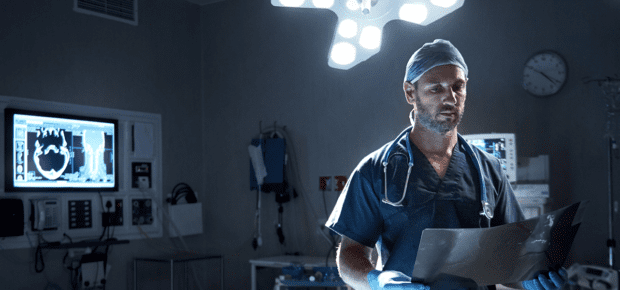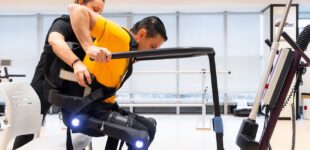August 31, 2018
Not too long ago, having an operation often meant getting a large, gory incision. Thanks in part to advances in robotics, many operations can now be performed through a keyhole opening, offering less pain and a quicker recovery, obviously great upsides.
But this method of operating isn’t without its technical challenges; a primary one, as you might guess given the miniaturization of the process, is the ability to see and judge depth and movement in these tiny spaces.
Fortunately, the technical hurdles cleared in developing this technology have also given rise to optical automation, which researchers are using to help counteract the problem. With the right setup, automated imaging can facilitate surgeons’ planning and execution of these complex procedures.
According to a paper published in IEEE Robotics & Automation Magazine, two high-resolution imaging techniques, pCLE, and OCT, “offer visualization of cellular-scale tissue details in situ, providing a real-time alternative to conventional biopsy and histopathology.” Diagnostic and surgical procedures involving the gastrointestinal tract and organs stand to particularly benefit from these technologies.
However, the paper says, since the field of view is tiny (often less than 1mm), images need to get stitched together to be useful, which is problematic for the camera’s operator, who must make movements with submillimeter accuracy in order for the final image to line up. Aside from the images becoming unusable if they fail, there’s also the risk of tissue damage from the camera apparatus itself.
Researchers have turned to robotics to help solve the problem. Using an automated scanning framework, they’ve been able to create “continuous 2-D mosaics without gaps or discontinuities, which represent a common problem.” Additionally, the high-resolution image feed can be fused in real time and reconstructed at a much larger scale, giving the surgeon a 3-D view of the site on which they’re operating.
In addition to imaging and assisting in keyhole surgeries, researchers are working toward getting robots to function autonomously in the operating room, charting their own surgical course and even optimizing surgery schedules.
The IEEE Robotics & Automation Society has a Technical Committee on Surgical Robotics working to address the constantly emerging scientific and technical challenges that come along with these advances. Their efforts are helping to increase the performance, usage, and acceptance of surgical robots around the world.
To hear more about the growing role of robots in healthcare, visit our hot topic video series.





 The Impact of Technology in 2025
The Impact of Technology in 2025 Quantum and AI: Safeguards or Threats to Cybersecurity?
Quantum and AI: Safeguards or Threats to Cybersecurity? Why AI Can't Live Without Us
Why AI Can't Live Without Us Bits, Bytes, Buildings and Bridges: Digital-Driven Infrastructure
Bits, Bytes, Buildings and Bridges: Digital-Driven Infrastructure Impact of Technology in 2024
Impact of Technology in 2024 Emerging AI Cybersecurity Challenges and Solutions
Emerging AI Cybersecurity Challenges and Solutions The Skies are Unlimited
The Skies are Unlimited Smart Cities 2030: How Tech is Reshaping Urbanscapes
Smart Cities 2030: How Tech is Reshaping Urbanscapes Impact of Technology 2023
Impact of Technology 2023 Cybersecurity for Life-Changing Innovations
Cybersecurity for Life-Changing Innovations Smarter Wearables Healthier Life
Smarter Wearables Healthier Life Infrastructure In Motion
Infrastructure In Motion The Impact of Tech in 2022 and Beyond
The Impact of Tech in 2022 and Beyond Cybersecurity, Technology and Protecting Our World
Cybersecurity, Technology and Protecting Our World How Technology Helps us Understand Our Health and Wellness
How Technology Helps us Understand Our Health and Wellness The Resilience of Humanity
The Resilience of Humanity Harnessing and Sustaining our Natural Resources
Harnessing and Sustaining our Natural Resources Creating Healthy Spaces Through Technology
Creating Healthy Spaces Through Technology Exceptional Infrastructure Challenges, Technology and Humanity
Exceptional Infrastructure Challenges, Technology and Humanity The Global Impact of IEEE's 802 Standards
The Global Impact of IEEE's 802 Standards Scenes of our Cyber Lives: The Security Threats and Technology Solutions Protecting Us
Scenes of our Cyber Lives: The Security Threats and Technology Solutions Protecting Us How Millennial Parents are Embracing Health and Wellness Technologies for Their Generation Alpha Kids
How Millennial Parents are Embracing Health and Wellness Technologies for Their Generation Alpha Kids Space Exploration, Technology and Our Lives
Space Exploration, Technology and Our Lives Global Innovation and the Environment
Global Innovation and the Environment How Technology, Privacy and Security are Changing Each Other (And Us)
How Technology, Privacy and Security are Changing Each Other (And Us) Find us in booth 31506, LVCC South Hall 3 and experience the Technology Moon Walk
Find us in booth 31506, LVCC South Hall 3 and experience the Technology Moon Walk Virtual and Mixed Reality
Virtual and Mixed Reality How Robots are Improving our Health
How Robots are Improving our Health IEEE Experts and the Robots They are Teaching
IEEE Experts and the Robots They are Teaching See how millennial parents around the world see AI impacting the lives of their tech-infused offspring
See how millennial parents around the world see AI impacting the lives of their tech-infused offspring Take the journey from farm to table and learn how IoT will help us reach the rising demand for food production
Take the journey from farm to table and learn how IoT will help us reach the rising demand for food production Watch technical experts discuss the latest cyber threats
Watch technical experts discuss the latest cyber threats Explore how researchers, teachers, explorers, healthcare and medical professionals use immersive technologies
Explore how researchers, teachers, explorers, healthcare and medical professionals use immersive technologies Follow the timeline to see how Generation AI will be impacted by technology
Follow the timeline to see how Generation AI will be impacted by technology Learn how your IoT data can be used by experiencing a day in a connected life
Learn how your IoT data can be used by experiencing a day in a connected life Listen to technical experts discuss the biggest security threats today
Listen to technical experts discuss the biggest security threats today See how tech has influenced and evolved with the Games
See how tech has influenced and evolved with the Games Enter our virtual home to explore the IoT (Internet of Things) technologies
Enter our virtual home to explore the IoT (Internet of Things) technologies Explore an interactive map showcasing exciting innovations in robotics
Explore an interactive map showcasing exciting innovations in robotics Interactively explore A.I. in recent Hollywood movies
Interactively explore A.I. in recent Hollywood movies Get immersed in technologies that will improve patients' lives
Get immersed in technologies that will improve patients' lives